The Great American Household Savings Myth
Economics / US Economy May 31, 2007 - 01:33 AM GMTBy: Paul_L_Kasriel
In the cover article of the May 28 edition of Barron's (see The Great American Savings Myth ) Gene Epstein, Barron's economics editor, argues that household saving is being underestimated. Epstein's argument centers principally on two issues – the growth in household net worth and the absence of spending on intangibles, such as research and development, from our official Gross Domestic Product (GDP)/saving statistics.
I offer a counterargument that increases in household net worth do not necessarily represent saving in an economic sense. I also present evidence showing that investment in human capital – higher education and research/development – has not shown any extraordinary growth since the official measures of household saving have been plummeting in recent years. If households are so wealthy, why have they recently been on a borrowing spree? If the return on business capital is so great, why have businesses been buying back record amounts of their equities rather than using their profits to spend more on physical and intellectual capital?
Firstly, let's discuss the concept of saving in an economic sense. Saving refers to spending your income (production) on things that will enable your income (production) to rise the future. This might involve spending on education that will enable you to earn a higher income in the future. This might involve purchasing newly issued corporate stocks and bonds, the proceeds of which are used by the corporation to purchase capital equipment or spend on research and development. In other words, saving involves spending present income on things that hold the prospect of producing future income. For the economy as a whole, saving means directing land, labor and capital (both human and tangible) toward the current production of goods and services that will enable additional future production. Saving s are the accumulation of past saving.
There are two ways that households can increase their net worth – net worth being the difference between the market value of their assets and the value of their liabilities. One way households can increase their net worth is to spend part of their current income on the acquisition of additional assets – stocks, bonds, deposits, houses and consumer durable goods. The other way households can raise their net worth is for the value of their previously acquired assets to rise, that is, capital appreciation.
In the postwar era, capital appreciation has been the dominant factor contributing to changes in household net worth. From 1952 through 2006, the median contribution to the change in net worth from capital appreciation has been 67%. But, as shown in Chart 1, in 11 of the past 12 years, the contribution from capital appreciation has been greater than the 67% median. In 2000, capital appreciation's contribution to the change in household net worth was right at the median. So, the sharp increases in household net worth that started in 1995 were not due to household saving in the economic sense.
Chart 1
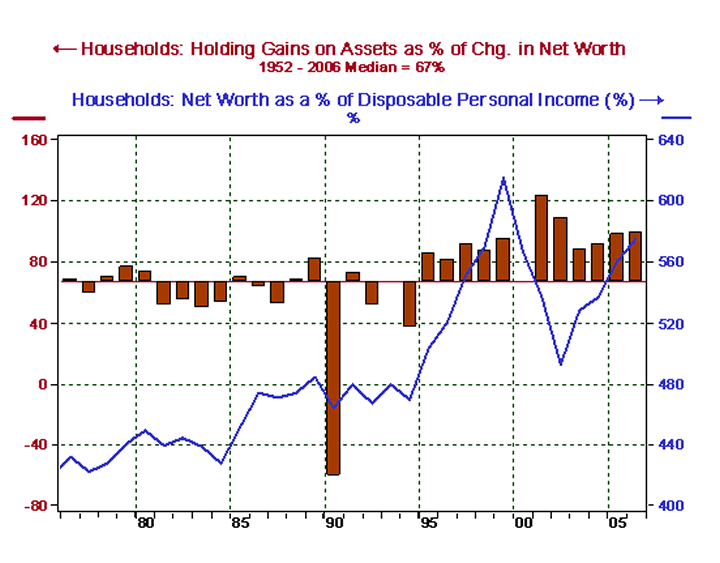
Now, does the increase in the price of an asset necessarily mean that the real output produced by that asset is growing apace with the nominal price of that asset? For example, in recent years there has been a rapid appreciation in the nominal value of residential real estate. Has the real value of housing services produced by the existing and new houses kept pace with the nominal increase in the value of owner-occupied real estate? No. Chart 2 shows that the real implicit rent on owner-occupied housing has been falling relative to the nominal market value of owner-occupied housing since the mid-1960s and the rate of that decline accelerated in recent years as the house-price appreciation took off. This is true not only for owner-occupied real estate but for all household assets.
Chart 3 shows that real GDP as a percent of the nominal market value of household assets has been steadily falling for years. This just demonstrates that the appreciation in the prices of assets does not mean that all of that appreciation represents increases in real economic wealth. If it did, then the residents of Zimbabwe would be experiencing very rapid increases in their real wealth (see the Ludwig von Mises Institute's Zimbabwe: Best Performing Stock Market in 2007? ).
Chart 2
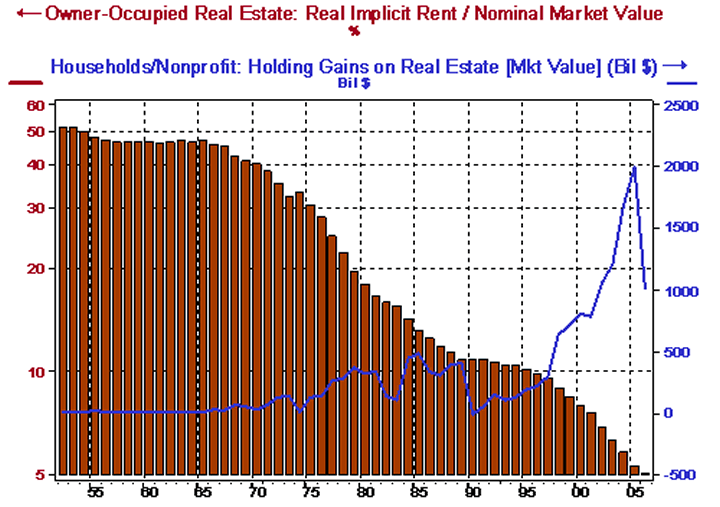
Chart 3
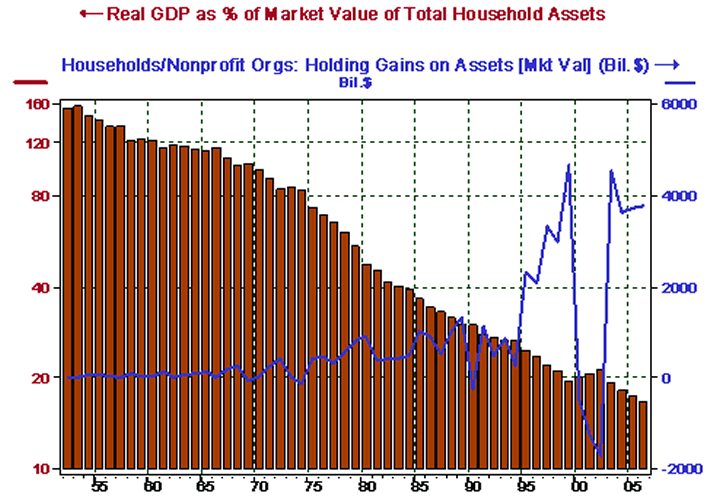
One factor that determines the wealth of an economy is how fast its real capital stock is growing. After all, its capital stock plays an important role in the production of future goods and services. Chart 4 shows the year-over-year percent change in the per capita U.S. capital stock, which includes private sector fixed assets, government sector fixed assets and consumer durable goods (motor vehicles, washing machines, etc.). The median annual percent increase in the U.S. per capita real capital stock from 1953 through 2005 was 1.88%. In all but three years from 1990 through 2005, the growth in the U.S. per capita real capital stock has been below the median. In those three years in which the capital stock growth was above the median – 1998, 1999 and 2000 – that growth was not extraordinary especially compared with that of second half of the 1960s.
Chart 4
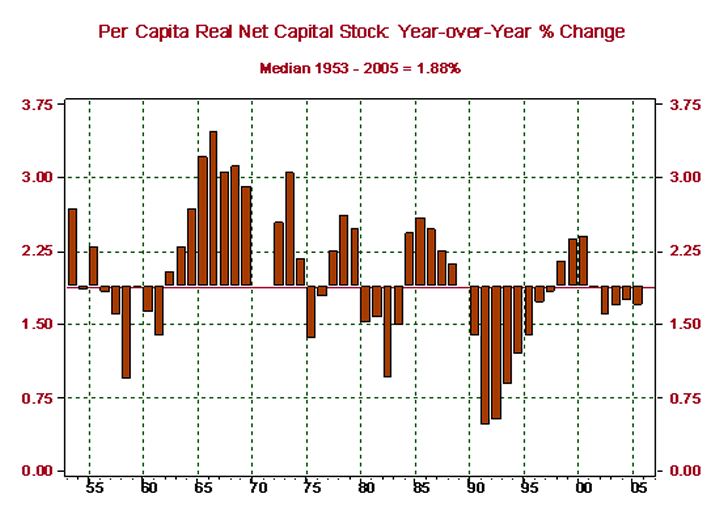
Not only has the growth in the U.S. real capital stock been slower in recent years, but the composition of that growth has shifted radically toward household-related capital stock vs. business-related. Chart 5 shows that the net capital stock of combined consumer durable goods and private residential dwellings started rising rapidly in 2000 relative to the net capital stock of the businesses. In 2005, the combined real household capital stock was a record high 143.4% of the real capital stock of businesses. Are 5,000-square-foot houses with flat screen televisions hanging on the walls and three SUVs with leather seats in the three-truck garages likely to enable the U.S. economy to produce more goods and services in the future than businesses' fixed investments in plant, equipment and software?
Chart 5
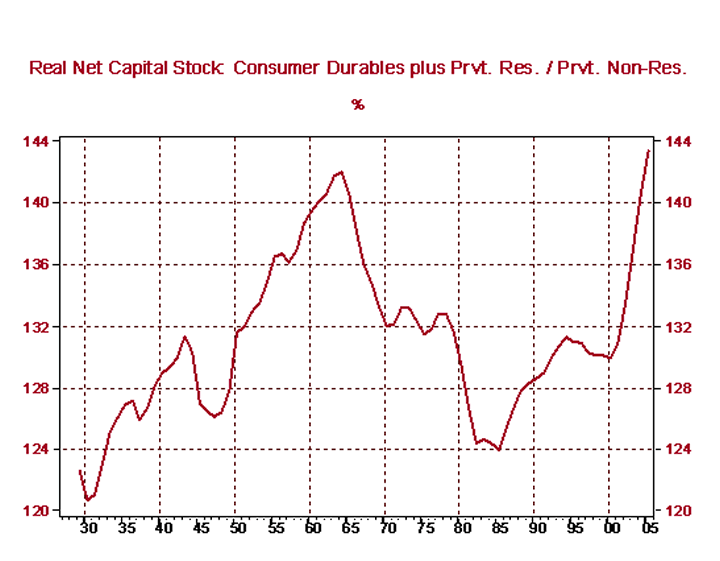
The nature of the U.S. economy has changed in recent decades. We are less and less metal benders and more and more idea benders. That is, the U.S. economy is becoming more knowledge-based as developing economies take on lower value-added manufacturing activity. So, perhaps looking at the growth or composition of U.S. tangible capital is less appropriate today. It might be better to look at measures related to human capital such as expenditures on research/development and higher education. Chart 6 shows the year-over-year growth in real higher-education expenditures and real research and development expenditures. (Real research and development expenditures were calculated by deflating nominal expenditures by the chain price index for higher education expenditures.) Since official measures of household saving have been plummeting, there has been no extraordinary pick up in investment in human capital.
Chart 6
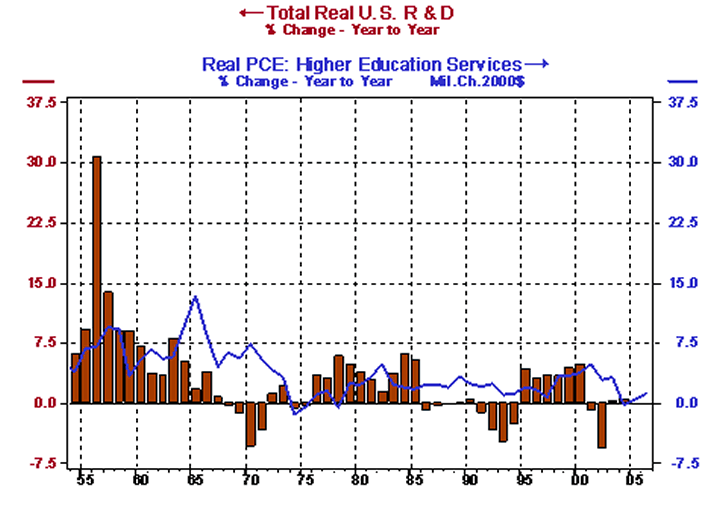
Epstein and other dissaving deniers argue that the official household saving data are biased downward because they subtract things from income and don't include other things in income. In the Federal Reserve's flow-of-funds data there is a series called “household net financial investment” that allows us to get at the heart of the saving issue. Net financial investment is the difference between households' net acquisition of financial assets – stocks, bonds, deposits, mutual funds, claims on pension and insurance reserves – and the net increase in their liabilities. How does one acquire financial assets? By spending less on goods, services and tangible assets than one's income and by borrowing funds to purchase financial assets. Let's put this in equation form:
(1) Net Acquisition of Financial Assets = Income – Spending + Borrowing
Now, let's re-arrange some terms:
(2) Income – Spending = Net Acquisition of Financial Assets – Borrowing
From Equation (2), we can see that if borrowing is greater than the net acquisition of financial assets, that is, the right-hand side of Equation (2) is negative, then the left-hand side of Equation (2) must be negative, also. So, if our borrowing exceeds our net acquisition of financial assets, then we are spending more on goods, services and tangible assets than we are earning (producing). Some might dare call this dis saving.
Let's take a look at households' net acquisition of financial assets and their net increase in liabilities. Chart 7 shows that starting in 1999, households' net increase in liabilities has exceeded their net acquisition of financial assets. From 1952 through 1998, households spent less on goods, services and tangible assets than they produced. But suddenly in 1999 through 2006, households started spending more than they produced.
Chart 7
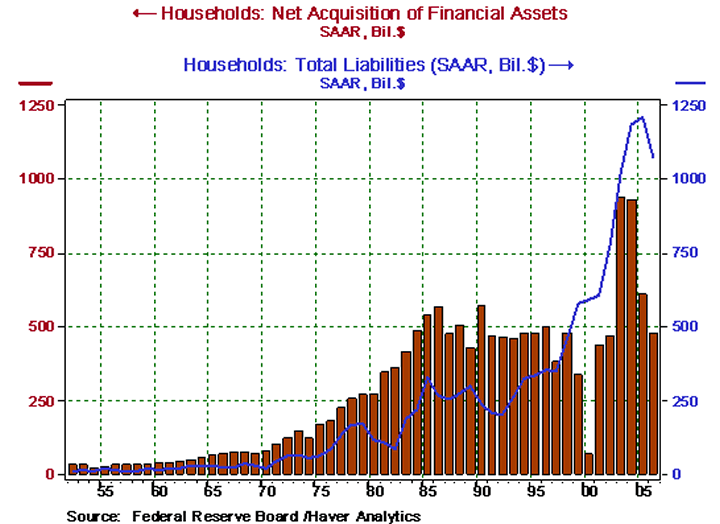
The difference between the two series in Chart 7 – net financial investment – is shown as a percent of personal income (before taxes) in Chart 8 along with the official measure of household saving, which uses after-tax income. The magnitudes of the two series are different, but the story is the same – U.S. households are spending more on goods, services and tangible assets than they currently are producing.
Chart 8
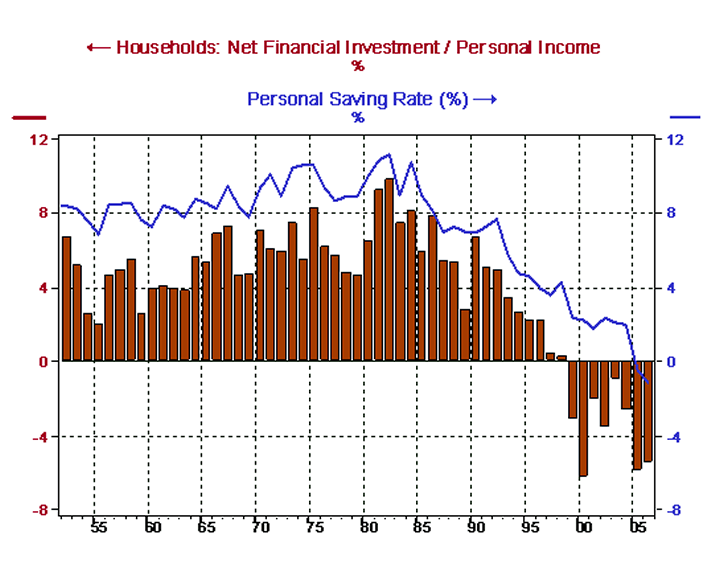
To paraphrase my dear mother, may she rest in peace, if we American households are so rich, why are we borrowing so much? Chart 9 shows that the net increase in household liabilities as a percent of personal income hit a postwar high in 2004 and remains above that of any year prior to 2002. Epstein and others talk so much about household net worth, but they never mention household leverage. Chart 10 shows that total household liabilities are at a postwar high compared to the market value of total household assets – tangible and financial. This implies that household debt has been growing faster than the market value of household assets at a time when we have seen extraordinary increases in the market value of household assets (see Chart 11).
Chart 9
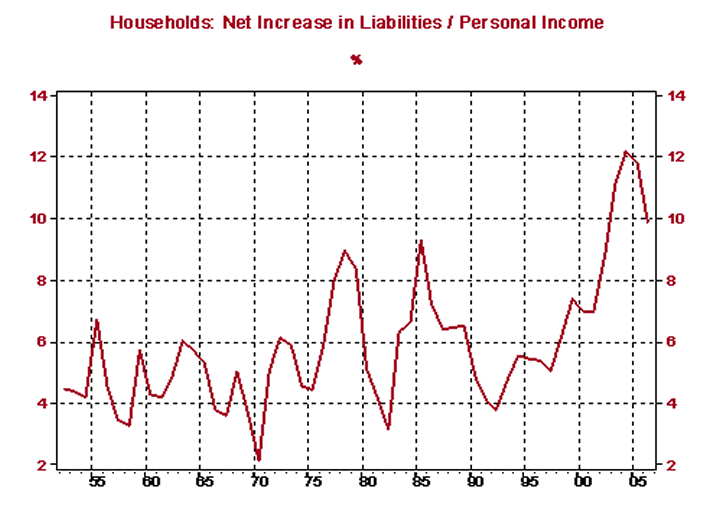
Chart 10
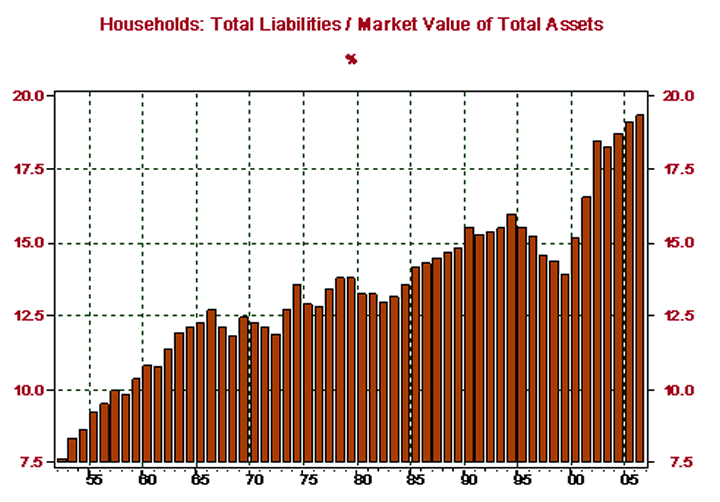
Chart 11
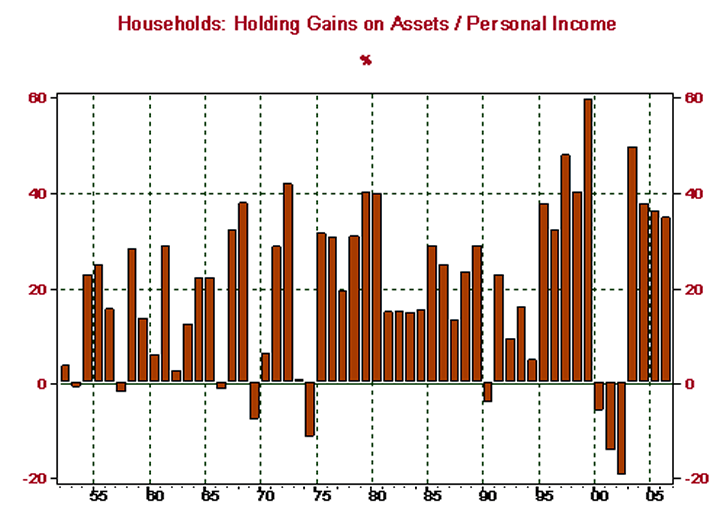
If households are intent on spending their holding gains on assets, it is not surprising that household borrowing has shot up. If I sell an inflated asset in order to fund additional spending, the buyer either has to cut back on his spending or borrow to fund the purchase of my asset. If the buyer cuts back on his spending, then, on net, total spending does not increase with the sale of my asset. If the buyer borrows in order to purchase my asset, then net spending increases, but so, too, does net borrowing. Alternatively, I could retain the asset, but use it as collateral for increased borrowing. This is exactly what thousands of “homeowners” have done in recent years.
Epstein argues that corporations are boosting the value of their shares, and thus, household net worth, by investing in tangible and intangible assets. Is it through investing in their businesses that corporations have been boosting shareholder value in recent years or rather by “investing” in their own shares? It would seem the latter. Chart 13 shows the annual net issuance of equities by U.S. corporations in relation to their profits. In 2006, in absolute as well as relative terms a record amount of corporate equities were “retired.” Corporations have been increasing households' net worth not so much by investing record profits in their businesses, but by using those profits to buy back their own shares. And now that profit growth is slowing, corporations have stepped up their borrowing to fund share buybacks, just as they did in the stock market bubble of the late 1990s (see Chart 14). Households have been “investing” the proceeds of these stock buybacks in McMansions and SUVs. Is this a combination destined to increase the future productive capacity of America?
Chart 13
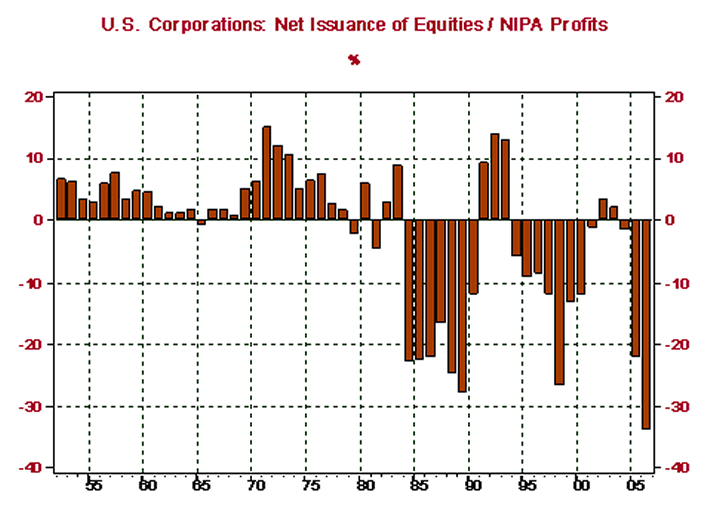
Chart 14
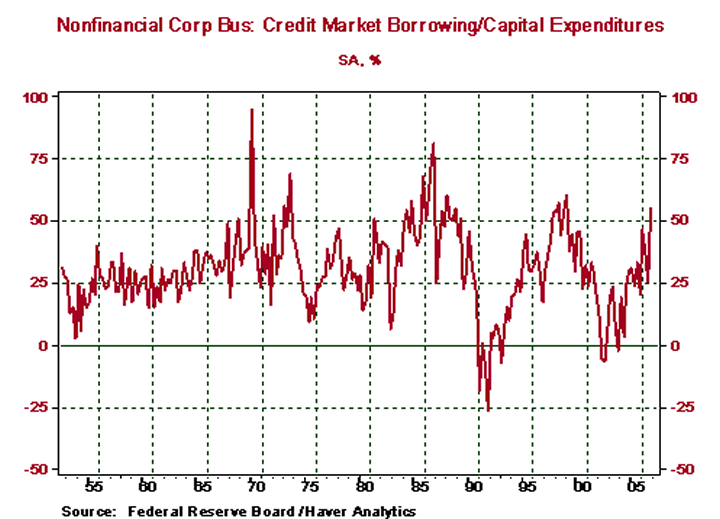
Gene Epstein claims to have an affinity for Austrian economics. In fact, he delivered the Hazlitt lecture at the 2000 Austrian Scholars Conference sponsored by the Ludwig von Mises Institute. After reading Epstein's latest Barron's article, I can only imagine that Ludwig is spinning in his grave!
*Paul Kasriel is the recipient of the 2006 Lawrence R. Klein Award for Blue Chip Forecasting Accuracy
By Paul L. Kasriel
The Northern Trust Company
Economic Research Department - Daily Global Commentary
Copyright © 2007 Paul Kasriel
Paul joined the economic research unit of The Northern Trust Company in 1986 as Vice President and Economist, being named Senior Vice President and Director of Economic Research in 2000. His economic and interest rate forecasts are used both internally and by clients. The accuracy of the Economic Research Department's forecasts has consistently been highly-ranked in the Blue Chip survey of about 50 forecasters over the years. To that point, Paul received the prestigious 2006 Lawrence R. Klein Award for having the most accurate economic forecast among the Blue Chip survey participants for the years 2002 through 2005.
The opinions expressed herein are those of the author and do not necessarily represent the views of The Northern Trust Company. The Northern Trust Company does not warrant the accuracy or completeness of information contained herein, such information is subject to change and is not intended to influence your investment decisions.
© 2005-2022 http://www.MarketOracle.co.uk - The Market Oracle is a FREE Daily Financial Markets Analysis & Forecasting online publication.



